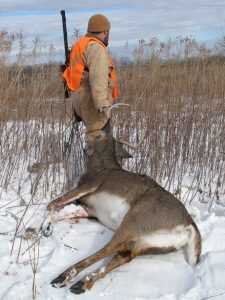
While tough to endure for the hunter, extreme cold weather can kick deer movement into overdrive, opening the door to late-season success.
SERIES
- Part 1: Top Four Tips To Scouting Now
- Part 2: Early Season Deer Stand Tips
- Part 3: Follow the Moon
- Part 4: Five Top Deer Gear Essentials
- Part 5: Five Top Backpacks
- Part 6: Essential Trail Camera Know-How
- Part 7: Making The Call
- Part 8: Keeping Warm
“I fish, but I don’t hunt. And not because I think it might somehow be more holy to eat meat that has been bludgeoned by somebody else; that’s not it,” says comedian Ron White in a now famous (and hilarious) skit on deer hunting. “It’s really early in the morning, it’s really cold outside and I don’t want to go.” Indeed, for anybody who has ever deer hunted, cold is a big part of the activity; especially in the northern half or Midwestern part of the country.
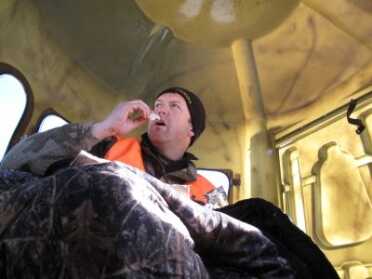
The author survives near blizzard conditions in comfort while enjoying a snack inside a shooting blind during an Iowa deer hunt one December.
But the cold can be the deer hunter’s friend as well. A good pre-rut chill can kick deer movement into overdrive while serious cold settling in during the late season can inspire deer to move and feed, providing opportunity for the hunter on the ground (or in a tree). However, cold can also be as challenging to withstand for the hunter as it can be for the deer. In fact, as our bodies aren’t acclimated or made to naturally withstand temperature extremes, it can be even tougher for us. For more hunters than can be counted throughout history, cold has spelled disaster for them as they encountered the harsh challenges unprepared or merely couldn’t endure them after becoming lost. In the now infamous Armistice Day storm of 1940, when wicked white-out conditions hit the upper Mississippi River region of the Midwest, nearly 200 people lost their lives, at least half of them duck hunters who got caught in their storm.
Of course, there wasn’t the Weather Channel, weather apps on smartphones, Gore-Tex or Thinsulate back then, either, which made all the difference. Simply knowing bad weather is coming and appropriately preparing for it would make a similar tragedy virtually impossible today, though cold weather still claims lives every year. If it’s that severe, maybe change your hunting days. But for those must-hunt days when the mercury simply plummets below the freezing mark and deer are on the move, get out there, but be prepared. Nothing gives a hunter’s location away to deer quicker than when that hunter is stomping, jumping or simply walking around to keep warm. Comfort and warmth are key, not only to make your sit on a stand tolerable, but to also help you remain still so the deer never know you are there. Follow these common-sense strategies and products to help you beat the chill this deer season and be in your stand when that monster buck decides to move during the late season.
Dress In Layers
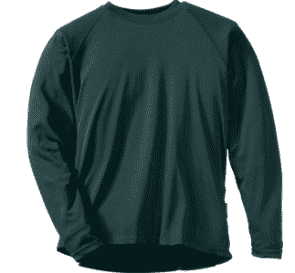
One of the author’s favorites for really cold weather is Cabela’s MTP Heavyweight Crew, made of a fleeced polyester. Image courtesy of manufacturer.
I still see hunters every year (mostly older ones; sorry Dad) who step from the warmth of a home or vehicle in just their flannel or camo shirt and hunting pants and put a single heavy coat on before walking to their stand. No doubt that coat will keep you warm; but walking to and from your stand it will also get you sweated up, which in turn creates moisture on your body and give you chills not long after you quit moving and are trying to get comfortable on the stand. Once those chills begin, they can be hard to beat; especially if you are planning on sitting outside in the cold for several hours. It’s a mantra worth repeating: Dress in layers.
Start with a good wicking base layer. Silk and Merino wool materials are best. Avoid the old-school cotton long johns. They hold moisture and will keep you soaked if you sweat. They also do little to actually keep you warm. I’m also not a fan of clothing that clings to your body like the casing on a sausage. A little room for air, that can warm from your body heat and remain trapped inside the clothing, goes a long way to improve the insulating and warmth capability of the clothes. One of my favorites for really cold weather is Cabela’s MTP Heavyweight Crew and Bottoms, which are made of a fleeced polyester that is super warm and super comfortable.
Beyond base layers, avoid cotton altogether when it comes to sitting outside in what is typically cold, damp weather when it comes to winter deer hunting. Choose clothing made of technical materials such as Gore-Tex lined garments that keep moisture out, but allow sweat vapor to escape. Go with light, loose pants and shirt, maybe a fleece or Polartec pull-over and a waterproof lined shell. If you choose to go with a heavier coat in extreme cold (wool still can’t be beat for warmth), strap it to a pack or frame and tote it in with you, putting it on only after you have gotten into your stand or blind and cooled back down from the walk.
Protect Your Extremities
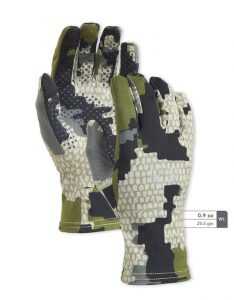
Kuiu Peloton 130 liner gloves offer a lot of protection for your hands in the cold. Image courtesy of manufacturer.
Hands and feet are the first parts of your body to begin feeling the effects of cold, particularly the feet, since you can’t stuff them into a pocket. And because working opposable thumbs is so damn important to everything we do, from carrying a firearm to climbing a tree stand, you need to encase those babies in a set of gloves or mittens that will fight off the chill. I typically prefer a light pair of gloves that won’t hamper the dexterity needed to operate the bolt or other action on a firearm, to reload, etc. Light gloves are enough to fight off the pain exposure of your skin to cold can cause while walking; but when in your stand, if needed, I can shove them easily into a hand-warmer filled pocket. For extreme temps, I like a mitten/glove hybrid where my fingers are encased in partial gloves covered by a fold-back mitten end for when it is time to fire or pick stuff up. Cabela’s MT050 Extreme II Glomitts are a great example of these. Kuiu has a pricey but darn good combo set that consists of the base layer glove, the Peloton 130 glove, made of polyester Primeflex knit material, under the Super Down Glassing Mitt, which a hunter would wear over top of it.
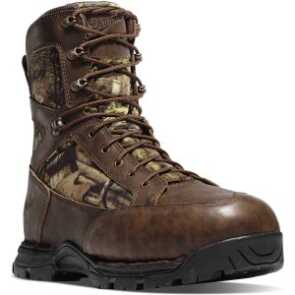
Properly protecting your feet in the cold is a must, and these Danner Pronghorn boots are a great option. Image courtesy of manufacturer.
Despite the importance of a good pair of gloves, the first line of keeping warm on the stand ultimately comes down to keeping feet warm. You do, after all, need to walk back from your stand at some point, and it’s hard to do that on legs that feel like nubs. Don’t skimp on boots. They tend to be expensive and there’s a reason for that … if made right, they will keep water and cold out, and warmth and comfort in. If you are doing a lot of walking or live in an area where temps mostly flirt with freezing, select a good leather or Cordura mix boot with 400 to 600 grams of Thinsulate or a comparable insulating material. Danner Pronghorns, Rocky Cornstalkers and Under Armour Brow Tines are all great options.
For extreme temps, short walks and long sits on a stand, a good set of pac boots with 1,200 to 2,000 grams of Thinsulate and/or removable insulating liners are the way to go. These boots are bulkier so they stink on long walks, but if you just plan on walking to your stand and then sitting tight for a while, they are the way to go. Key models include Lacrosse Ice Kings, Sorel Caribou Wool Boots and Schnee’s Extremes. For added protection once on your stand, slip on a pair of ArcticShield Boot Insulators, which fit right over your boots like a big foot mitten and lock in a layer of body heat.
Additional Cold-Weather Gear
A Heater Body Suit is probably the best thing ever made for hunters trying to withstand brutal cold and still stay functionally in the hunt. Basically a durable, super-insulated sleeping bag that zips up around the hunter and his firearm but contains internal shoulder straps so he can slip from it easily when it’s time to make the shot, the Heater Body Suit is THE ticket when it comes to surviving long hunts in sub-zero temps. I once sat in a stand all day in single-digit temps and never, and I mean never, felt chilled or became uncomfortable.
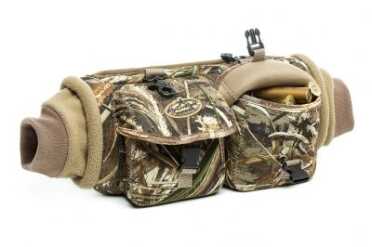
The Rig ‘Em Right Neoprene Hand Warmer Gear Belt is a great option for cold weather. Image courtesy of manufacturer.
Whether you opt for multiple packs of air-exposed, heat-generating hand warmers and foot warmers from HotHands or an old-school, but long-lasting and super-heat generating butane-powered Zippo, everyone needs to tote a handwarmer. The former generates less scent, but then, if it’s something worth shooting, I plan to have it down before it whiffs the butane softly smoldering deep in my pocket anyway. Zip them in a Rig’ Em Right Neoprene Hand Warmer Gear Belt for the ultimate hand-warming comfort.
Or, when all else fails, get out of the elements altogether and either build yourself a shooting house complete with comfy seat and Mr. Heater Hunting Buddy Portable Heater, or you can buy a complete shooting house from Boss Buck or Redneck Blinds, put it up in a matter of hours and hunt like a king no matter what the temp. Of course, expect to pay anywhere from $800 to more than $2,000 for the convenience factor.

You said, “Whether you opt for multiple packs of air-exposed, heat-generating hand warmers and foot warmers from HotHands or an old-school, but long-lasting and super-heat generating butane-powered Zippo, everyone needs to tote a handwarmer.”
I’ve tried finding a butane-powered Zippo handwarmer to no avail. All that I’ve looked at require naptha (lighter fluid). Can you provide a model number? Price? Availability?
The Hothands are perfect for everything, including throwing them in the bottom of your sleeping bag for extra warmth.
Stick em under your hat, in the backside of gloves or mittens, and even on top of your toes.
Tried the NAFTA Made in Iraqapakiastainee stuff, The real cold weather stuff is in Bozeman, Montana made with Rambouiliet
Merino Wool grown in MT. The company’s name is DUCKWORTH if you want the best.
Don’t know ’bout new stuff but I do know that it’ll be hard to beat Marino wool,,Smart Wool and the like..